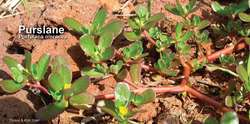purslane
Ground cover plant with reddish spaghetti-like stems and green waxy propeller shaped leaves, yellow flowers. Loves sunlight, not shade. Eat the stems along with the leaves. Has a refreshing tart lemony flavor. In North America it's considered a weed, in other countries it's a popular salad vegetable. It is the highest herbal land plant source of Omega 3, 6 and even some omega 9 fatty acids. Extremely rich in Vitamin C. Contains dopa and noradrenaline (norepinephrine), making it great for allergies, growth hormone production, thyroid, adrenal, pituitary, and the entire endocrine system (all glands). Very delicious and nutritious. Can eat raw or steam for 15 seconds, add butter, salt and pepper, mmmmn. You can take the stems, marinate them and use as noodles.You can also take the whole plant, dehydrate it and make purslane powder which you can sprinkle on things through the winter months. Very delicious, very nutritious and heart healthy. Can spread a lot- they drop 50,000 seeds at one time. The only plant that looks like purslane but isn't really edible is spurge. The way to tell the difference is spurge has a white sap inside the stem, which isn't red like purslane stems. Purslane makes a good companion plant by providing ground cover to create a humid microclimate for nearby plants, stabilizing ground moisture. Its deep roots bring up moisture and nutrients that those plants can use.
Edible Plant Guide © 2012 Markus Rothkranz


